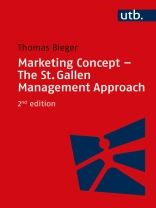This book presents marketing and business processes as an integral part of the St. Gallen Management Model. It provides a tight introduction into the field of marketing and puts the added value in the center of a market-oriented management approach. The book addresses relevant topics such as market analysis, marketing planning, marketing strategy, positioning, application of marketing tools, product design, price, distribution and communication policy, service provision, innovation and controlling processes.
This book aims at students in the first year as well as at practitioners who wants to obtain a quick overview of this field.
Table of Content
Table of figures 13
1 Business processes and marketing concept within the St. Gallen Management Model — an introduction 17
1.1 Case study Läderach 17
1.2 Value-creation processes, enterprises and management 20
1.2.1 Value-creation chains and processes 20
1.2.2 Organizations, enterprises and management 24
1.2.3 Enterprise and environment 26
1.3 Embedding of business processes in the St. Gallen Management Model 28
1.3.1 Stakeholders 29
1.3.2 Environment 31
1.3.3 Environments and sustainability 33
1.3.4 Structuring forces 34
1.3.5 Business processes in the St. Gallen Management Model 36
1.4 Objectives of business processes 38
1.5 Structure of business processes 42
1.5.1 Service-provision processes 43
1.5.2 Customer processes 46
1.5.3 Innovation processes 49
1.6 The marketing approach for the management of business processes 51
1.6.1 Development of marketing 51
1.6.2 Planning approach in marketing 53
2 Market analysis as the basis for market-oriented business management 55
2.1 Case study Mammut 55
2.2 Customer behavior and markets 57
2.2.1 Definition and role of markets 57
2.2.2 Players and market types 58
2.2.3 Motives, needs, benefit and demand 63
2.3 Market research objectives and data generation 69
2.3.1 Identifying market sizes, needs and decision-making 69
2.3.2 Supply-and-demand trends 73
2.4 SWOT analysis as a synthesis of market analysis 81
3 Marketing strategy — from market segmentation to a positioning strategy 85
3.1 Case study Jura 85
3.2 Marketing objectives 87
3.2.1 Corporate objectives and marketing objectives 89
3.2.2 Interaction of marketing objectives 90
3.3 From market segmentation to a positioning strategy 93
3.3.1 Segmentation criteria and segmentation level 93
3.3.2 Choice of target market 98
3.3.3 Positioning 98
3.4 From customer processes to tool strategy 99
3.4.1 Determinants of tool application 99
3.4.2 Focus on marketing tool application in the marketing mix 104
4 Product design and performance 107
4.1 Case study Stadler Rail 107
4.2 Product design 109
4.3 Performance provision — physical product 115
4.3.1 Basic structure of the performance process 115
4.3.2 Strategic decisions 117
4.3.3 Operational decisions 121
4.4 Performance provision — services 123
4.4.1 Characteristic features of services 124
4.4.2 Performance design and control of the service process 128
4.4.3 From service chain to service blueprint 130
5 Marketing tool application 135
5.1 Case study Jungfraubahn 135
5.2 Pricing policy 137
5.2.1 Neoclassic pricing model 138
5.2.2 Behavioral-science pricing models 140
5.2.3 Functions of pricing 142
5.3 Distribution policy 145
5.3.1 Functions of distribution 146
5.3.2 Distribution design 147
5.4 Communication 150
5.4.1 Role and function of communication 150
5.4.2 Organizational scopes of communication 152
5.4.3 Communication change 154
5.5 Marketing mix 155
5.5.1 Objectives of the marketing mix 155
5.5.2 Planning the marketing mix 156
6 Integration into a business model, controlling and innovation 159
6.1 Case study Swiss web portal 159
6.2 Integration into a business model 161
6.3 Marketing controlling 164
6.3.1 Development of a controlling concept 165
6.3.2 Characteristics of marketing controlling 167
6.3.3 Contribution accounting 168
6.4 Innovation 170
6.4.1 Functions, roles and tools of innovation 170
6.4.2 Return on innovation 172
6.4.3 Innovation in models 173
6.4.4 Innovation’s directions of impact 175
Bibliography 179
Alphabetical Index 197
About the author
Prof. Dr. Thomas Bieger ist Ordentlicher Universitätsprofessor für Betriebswirtschaftslehre mit besonderer Berücksichtigung der Tourismuswirtschaft an der Universität St. Gallen.












